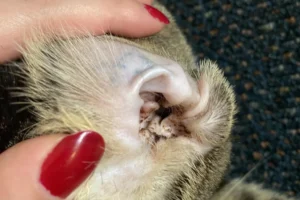Cats have a remarkable ability to always land on their feet, no matter how high they fall. But why is that? Let’s explore the fascinating science behind this unique skill.
Cats Have an Incredible Adaptation:
Understanding the Physics Behind the Phenomenon
Have you ever marveled at how a cat always manages to land on its feet? It’s not just luck – it’s science! A cat’s flexible spine and inner ear are the real MVPs in this mid-air acrobatics show.
When a cat takes a leap, its unique anatomy allows it to twist its body in a split second. The flexibility of their spine enables them to rotate their front and back halves independently, ensuring they can reorient themselves mid-fall.
But it’s not just the spine doing all the work. A cat’s inner ear contains vestibular apparatus, which helps them maintain balance and spatial orientation. This means they can quickly adjust their position to ensure a perfect landing every time.
So, next time you watch your feline friend gracefully land on their feet, remember – it’s all about the incredible physics at play!
Exploring the Role of the Tail in Mid-Air Maneuvers
It’s time to give some credit to the unsung hero of a cat’s acrobatic skills – their tail. While cats may seem like they’re all about their whiskers and paws, their tail plays a crucial role in ensuring a flawless landing.
You see, when a cat is in mid-air, their tail acts as a counterbalance. By shifting the position of their tail, cats can adjust their body’s center of gravity, helping them control their descent and land gracefully on their feet.
Next time you watch your cat perform a gravity-defying leap, pay attention to how they use their tail to maintain poise and precision. It’s truly a tail-wagging marvel to behold!
Analyzing the Instinctual Behavior of Cats
Have you ever marveled at how cats always seem to land on their feet, no matter how they fall? Well, it’s not just luck – it’s instinct! Cats have a remarkable ability to twist and contort their bodies in mid-air, allowing them to reorient themselves and land on their feet. This incredible feat is a result of their instinctual behavior honed over centuries of evolution.
When a cat falls, they enter a state known as the “righting reflex.” This reflex is triggered by the inner ear, which helps the cat maintain balance and sense its orientation in space. As the cat begins to fall, they quickly rotate their body to ensure that their feet are facing downward. By arching their back and rotating their front and back legs in opposite directions, cats are able to maneuver their bodies in mid-air and land safely on their feet.
This behavior is not just a party trick – it’s essential for a cat’s survival in the wild. Cats are natural climbers and hunters, so being able to land on their feet ensures that they can quickly recover from a fall and continue their pursuit of prey or escape from danger. So, next time you see your feline friend take a tumble, remember that it’s all thanks to their incredible instinctual abilities.
Debunking Common Myths About Cats and Falling
Let’s set the record straight – cats are not magical beings with the power to defy gravity or cheat death. Despite their impressive ability to land on their feet, there are still some common misconceptions about cats and falling that need to be debunked.
Myth 1: Cats always land on their feet – While cats have a remarkable righting reflex, it doesn’t guarantee that they will always land on their feet. Factors such as the height of the fall, the cat’s awareness, and the surface they land on can all affect the outcome of a fall.
Myth 2: Cats can survive any fall – While cats are known for their agility and resilience, they are not invincible. Cats can still suffer injuries from high falls, with taller heights increasing the risk of serious harm. It’s always important to supervise your cat and ensure they are safe from high places where they could potentially fall.
Myth 3: Cats always land on their feet because they have nine lives – This myth is just plain silly. Cats don’t have nine lives – they have one, just like any other living creature. Their ability to land on their feet is a result of their natural instincts and reflexes, not some supernatural power.
Remember, while cats are skilled at landing on their feet, they are not immune to the dangers of falling. It’s essential to keep a watchful eye on your feline friend and take precautions to keep them safe from potential falls.
Examining the Evolutionary Advantage of this Skill
Cats’ ability to land on their feet is truly remarkable and has been honed over millions of years of evolution. Natural selection favored individuals with this acrobatic skill, as it provided a distinct advantage in escaping predators and hunting prey in their natural habitats. The adaptation of flexible spines and a heightened sense of balance have allowed cats to twist and turn mid-air to ensure they always land on their feet, reducing the risk of injury from falls.
Moreover, this skill is also vital for navigating their surroundings with agility, whether it’s hunting small prey or avoiding danger. In the wild, where survival is a constant challenge, cats that can effectively land on their feet have a better chance of thriving and passing on their genes to the next generation.
Investigating the Training Techniques of Acrobatic Felines
Circus trainers and performers have long been enamored with the acrobatic abilities of cats, using their natural talent to create mesmerizing acts that captivate audiences worldwide. Through positive reinforcement techniques, trainers work with cats to enhance their innate ability to land on their feet with precision and grace.
One key training method involves encouraging play behaviors that mimic the movements required for mid-air flips and landings. By rewarding the cats for successfully completing these actions, trainers reinforce the desired behavior and help them develop their acrobatic skills further.
Tips for harnessing and cultivating this natural skill:
- Start training early: Kittens are more malleable and receptive to learning acrobatic maneuvers.
- Use treats as rewards: Positive reinforcement goes a long way in encouraging cats to hone their acrobatic skills.
- Stay patient and consistent: Training takes time, so be persistent and provide regular practice sessions to help cats master their acrobatic talents.
Remember, while cats may possess the innate ability to land on their feet, training and practice are essential for fine-tuning this skill and showcasing their acrobatic prowess.
Revealing the Dangers of High-Rise Syndrome in Cats
Cats are known for their incredible ability to land on their feet, thanks to a unique air-righting reflex. However, this skill can sometimes lead to serious injuries in a phenomenon known as high-rise syndrome. When cats fall from great heights, they may sustain broken bones, lung injuries, or even serious trauma. It’s essential for cat owners to be aware of the risks associated with high-rise syndrome and take necessary precautions to prevent their feline friends from falling out of windows or off balconies. Always ensure that windows are securely screened, and balcony railings are too high for curious cats to climb over.
Uncovering Surprising Similarities Between Cats and Other Animals
Did you know that cats aren’t the only animals capable of surviving falls from significant heights? Squirrels and rats also possess impressive resilience when it comes to landing safely after a fall. These creatures share a similar instinct to twist their bodies mid-air and spread out their limbs to slow down their descent, reducing the impact on landing. It’s truly fascinating how these seemingly unrelated animals exhibit comparable adaptabilities in the face of gravity’s challenge. Remember, it’s not just cats that possess this extraordinary trait—nature has equipped various species with survival mechanisms that continue to awe and inspire us.
Squirrels : Like cats, squirrels use their flexible bodies to reorient themselves during a fall, allowing them to land safely on their feet.
Rats : Surprisingly, rats also have the ability to twist and adjust their bodies in mid-air to minimize the impact of a fall, demonstrating a remarkable level of agility and adaptability.
Keep in mind the resilience and agility displayed by not only cats but also other animals when encountering the mysteries of gravity. There’s a remarkable synchronicity in nature’s design that transcends species boundaries.
Alex, a passionate animal lover, has experience in training and understanding animal behavior. As a proud pet parent to two dogs and three cats, he founded AnimalReport.net to share insights from animal experts and expand his knowledge of the animal kingdom.









